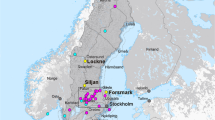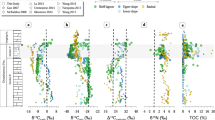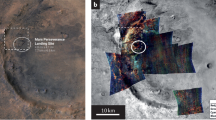Abstract
Microorganisms have flourished in the oceans since at least 3.8 billion years (3.8 Gyr) ago1,2, but it is not at present clear when they first colonized the land. Organic matter in some Au/U-rich conglomerates and ancient soils of 2.3–2.7 Gyr age has been suggested as remnants of terrestrial organisms3,4,5. Some 2.7-Gyr-old stromatolites have also been suggested as structures created by terrestrial organisms6,7. However, it has been disputed whether this organic matter is indigenous or exogenic, and whether these stromatolites formed in marine or fresh water. Consequently, the oldest undisputed remnants of terrestrial organisms are currently the 1.2-Gyr-old microfossils from Arizona, USA8. Unusually carbonaceous ancient soils—palaeosols—have been found in the Mpumalanga Province (Eastern Transvaal) of South Africa9. Here we report the occurrences, elemental ratios (C, H, N, P) and isotopic compositions of this organic matter and its host rocks. These data show that the organic matter very probably represents remnants of microbial mats that developed on the soil surface between 2.6 and 2.7 Gyr ago. This places the development of terrestrial biomass more than 1.4 billion years earlier than previously reported.
This is a preview of subscription content, access via your institution
Access options
Subscribe to this journal
Receive 51 print issues and online access
$199.00 per year
only $3.90 per issue
Buy this article
- Purchase on Springer Link
- Instant access to full article PDF
Prices may be subject to local taxes which are calculated during checkout




Similar content being viewed by others
References
Mojzsis, S. J. et al. Evidence for life on Earth before 3,800 million years ago. Nature 384, 55–59 (1996).
Rosing, M. T. 13C-depleted carbon microparticles in >3700-Ma sea-floor sedimentary rocks from west Greenland. Science 283, 674–676 (1999).
Hallbauer, D. K. & van Warmelo, K. T. Fossilized plants in thucholite from Precambrian rocks of the Witwatersrand, South Africa. Precambr. Res. 1, 199–212 (1974).
Gay, A. L. & Grandstaff, D. E. Chemistry and mineralogy of Precambrian paleosols at Elliot Lake, Ontario, Canada. Precambr. Res. 12, 349–373 (1980).
Mossman, D. J. & Fallow, C. E. G. in Early Organic Evolution: Implications for Mineral and Energy Resources (eds Schidlowski, M. et al.) 67–75 (Springer, Berlin, 1992).
Buck, S. G. Stromatolite and ooid deposits within the fluvial and lacustrine sediments of the Precambrian Ventersdorp supergroup of South Africa. Precambr. Res. 12, 311–330 (1980).
Buick, R. The antiquity of oxygen photosynthesis: Evidence from stromatolites in sulfate-deficient Archean lakes. Science 255, 74–77 (1992).
Horodyski, R. J. & Knauth, L. P. Life on land in the Precambrian. Science 263, 494–498 (1994).
Martini, J. E. J. A Late Archean–Paleoproterozoic (2.6 Ga) paleosol on ultramafics in the Eastern Transvaal, South Africa. Precambr. Res. 67, 159–180 (1994).
Wright, V. P. in Quantitative Diagenesis: Recent Developments and Applications to Reservoir Geology (eds Parker, A. & Sellwood, B. W.) 95–123 (Kluwer Academic, Dordrecht, 1994).
Rettallack, G. J. Soils of the Past: Introduction to Paleopedology (Unwin Hyman, Boston, 1990).
Naraoka, H., Ohtake, M., Maruyama, S. & Ohmoto, H. Non-biogenic graphite in 3.8-Ga metamorphic rocks from the Isua District, Greenland. Chem. Geol. 133, 251–260 (1996).
Watanabe, Y., Naraoka, H., Wronkiewicz, D. J., Condie, K. C. & Ohmoto, H. Carbon, nitrogen, and sulfur geochemistry of Archean and Proterozoic shales from the Kaapvaal Craton, South Africa. Geochim. Cosmochim. Acta 61, 3441–3459 (1997).
Des Marais, D. J. Isotopic evolution of the biogeochemical carbon cycle during the Proterozoic eon. Org. Geochem. 27, 185–193 (1997).
Des Marais, D. J., Bauld, J., Palmisano, A. C., Summons, R. E. & Ward, D. M. in Proterozoic Biosphere: A Multidisciplinary Study (eds Schopf, J. W. & Klein, C.) 299–308 (Princeton Univ. Press, Lawrenceville, 1992).
Brocks, J. J., Logan, G. A., Buick, R. & Summons, R. E. Archean molecular fossil and the early rise of eukaryotes. Science 285, 1033–1036 (1999).
Campbell, S. E. Soil stabilization by a prokaryotic desert crust: implications for Precambrian land biota. Origin of Life and Evolution of the Biosphere 9, 335–347 (1976).
Nisbet, E. G. in Early Precambrian Processes (eds Coward, M. P. & Ries, A. C.) 27–51 (Special Publication, Geological Society of London, 1995).
Ohmoto, H. Evidence in pre-2.2 Ga paleosols for the early evolution of atmospheric oxygen and terrestrial biota. Geology 24, 1135–1138 (1996).
Luque, F. J., Pasteris, J. D., Wopenka, B., Rodas, M. & Barrenechea, J. F. Natural fluid-deposited graphite: Mineralogical characteristics and mechanisms of formation. Am. J. Sci. 298, 471–498 (1998).
Strauss, H. & Moore, T. B. in Proterozoic Biosphere: A Multidisciplinary Study (eds Schopf, J. W. & Klein, C.) 709–797 (Princeton Univ. Press, Lawrenceville, 1992).
Ruttenberg, K. C. & Goni, M. A. Phosphorous distribution, C: N: P ratios, and δ13Coc in arctic, temperate, and tropical coastal sediments: tools for characterizing bulk sedimentary organic matter. Mar. Geol. 139, 123–145 (1997).
Ohmoto, H. & Goldhaber, M. B. in Geochemistry of Hydrothermal Ore Deposits (ed. Barnes, H. L.) 517–612 (Wiley & Sons, New York, 1997).
Acknowledgements
We thank T. Nagase for TEM analyses, L. R. Kump, J. F. Kasting, H. Naraoka, K. Yamaguchi, S. Ono, Y. Huang, K. M. Towe and J. A. Lamberski for comments on an earlier manuscript, and R. Capo, B. Stewart, D. J. Des Marais, R. Buick and J. M. Hayes for discussions. This work was supported by grants to H.O. from the Japanese Ministry of Science and Education, NSF and NASA.
Author information
Authors and Affiliations
Corresponding author
Rights and permissions
About this article
Cite this article
Watanabe, Y., Martini, J. & Ohmoto, H. Geochemical evidence for terrestrial ecosystems 2.6 billion years ago. Nature 408, 574–578 (2000). https://doi.org/10.1038/35046052
Received:
Accepted:
Issue Date:
DOI: https://doi.org/10.1038/35046052
This article is cited by
-
Accumulation of radiocarbon in ancient landscapes: A small but significant input of unknown origin
Scientific Reports (2023)
-
A global network model of abiotic phosphorus cycling on Earth through time
Scientific Reports (2022)
-
Role of endogenic and exogenic processes in the grusification and pedogenesis of weathered mantle, Precambrian granite of Dharwar Craton (India)
Arabian Journal of Geosciences (2022)
-
Precambrian and early Cambrian palaeobiology of India: Quo Vadis
Proceedings of the Indian National Science Academy (2021)
Comments
By submitting a comment you agree to abide by our Terms and Community Guidelines. If you find something abusive or that does not comply with our terms or guidelines please flag it as inappropriate.



